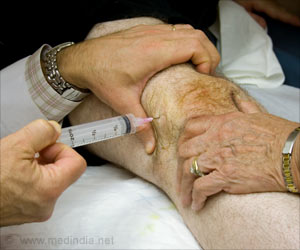Injections of hyaluronic acid (HA) are a common treatment of pain in osteoarthritis of the knee - a condition that affects 27 million Americans.

‘Depletion of natural hyaluronic acid from the joints can cause pain and stiffness due to lack of lubrication between bones moving against each other. The hyaluronic injections replace this natural hyaluronic acid that has depleted from the joints.’





A research group led by Lawrence Bonassar, professor of biomedical engineering, and graduate student Edward Bonnevie has discovered that another molecule, lubricin, helps anchor HA at the tissue surface, which, in turn, helps to move cartilage into a low-friction regime. Bonassar said, "The implication of this finding is that the efficacy of HA treatment might depend on how much lubricin is in the joint at the time of injection, which could explain why clinical trials of HA have such variable outcomes and may also suggest new formulations of HA that might be even more effective in the clinic." The study is published in PLOS ONE. Bonassar said, "Researchers examined how multiple formulations of HA lubricated cartilage and found that they all worked by a similar mechanism, one that is very similar to how a car hydroplanes on a wet road. Essentially, the viscous HA solutions form pressurized films that lower the friction coefficient of cartilage, particularly at higher sliding speeds. For many years, people doubted that this mechanism could happen in cartilage because the tissue is both flexible and porous. In this paper, we show definitively that cartilage can move to this low-friction domain in the presence of highly viscous HA solutions."
Scientists from Fidia Farmaceutici S.p.A. co-authored the study and used the results to bioengineer a new derivative of natural HA. This new HA derivative, has been approved by the FDA for clinical use in the U.S.
Dr. Cynthia Secchieri, Director of Research and Development at Fidia Farmaceutici S.p.A. said, "We are proud to have contributed to this important discovery. This research is a result of Fidia's long-term focus and commitment to HA research and development. We now have a new generation hyaluronic acid with increased elasticity, viscosity and residence time in the joint."
Source-Eurekalert














